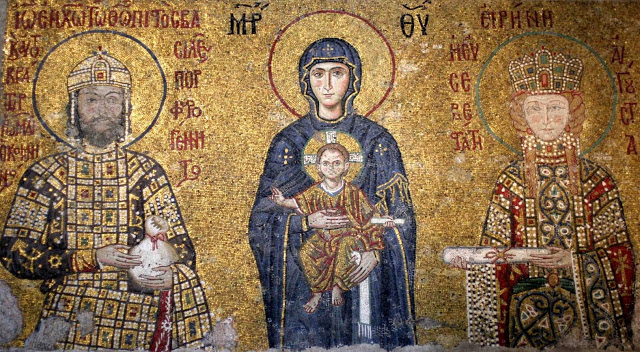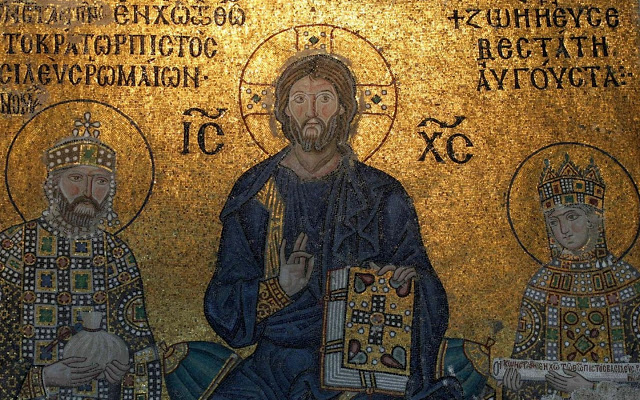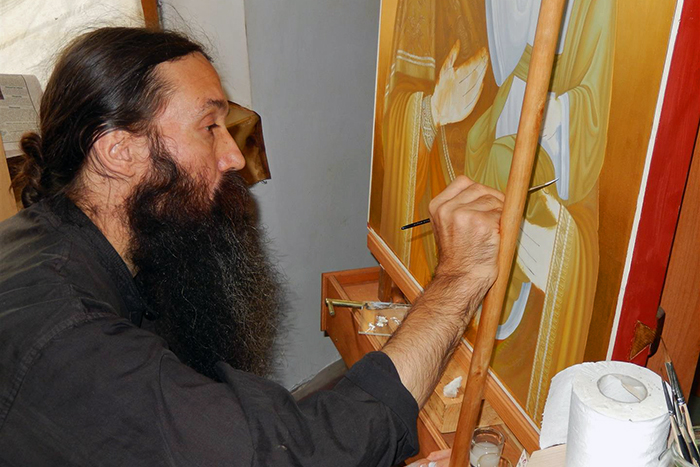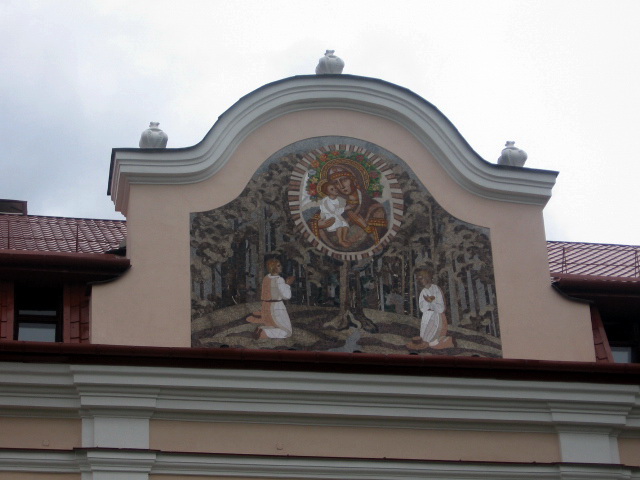
Icon inscriptions are symbols and acronyms accepted in the Russian Orthodox icon-painting tradition. Inscriptions can be made both in Church Slavonic and in Greek language. In these inscriptions, contracture is widely used (from lat. “shrinking”), which is writing a reduced form of a word with the help of its first and last letters. Above such words, a special symbol called titlo ( ҃ ) is written. The reduced form of the name Jesus Christ, consisting of two pairs of letters is IC XC. The cruciform halo reminds us about the Savior’s death on the Cross, the redemptive effect of which covered the whole world – “it is crosswise, for with the Cross He saved the world”. Number “four” is the symbol of spatial fullness. Four “ends”, which make a cross, connect four cardinal points.
In three visible sides of the cross within the halo, the Greek word O Ѡ N is written, which means “I AM”. That manner appeared in the 11th century. This inscription highlights the Divine nature of Jesus Christ in accordance with the revelation Moses got from the bush: “I am Who I am” (Exodus 3:14).
In Russian icon-painting tradition, Greek letter Ѡ (omega) is replaced by Ѿ (ot).
On Greek and Bulgarian icons, letter O (omicron) is placed on the left, Ѡ (omega) – in the top, N (nu) – on the right. The whole inscription is read in a circle from left to right.
For Russian icons a different order is more common: Ѡ (o) or Ѿ (ot) is on the left, Ѻ (on) in in the top, Н (nash) is on the right. The inscription is read by lines beginning from the top and then from left to right in the second line.
It must be noted that the biblical explanation of the words was not the only one in ancient Rus. From the old-rite literature, we can learn that there was another explanation. Perhaps, it was naïve to some extent, but still it did not violate any dogmatic rules of the Church. According to it, three letters expressed first of all three natures of God. Secondly, the Divine nature of Jesus Christ: Ѿ (ot) – “fatherly”. Ѻ (on) – “oum”, Н (nash) – “inconceivable Son”. Thirdly, the incarnation of the Son of God and His sufferings: Ѿ (ot) – “from Heaven He came”, Ѻ (on) – “they who did not conceive Me”, Н (nash) – “crucified on the Cross”.
As can be seen from these explanations, the order of reading the symbols was also not unified and could be changed, tearing apart any connections with the Greek tradition and replacing the words “I AM” with the word Ѿ Ѻ Н .

Inscriptions on icons
The inscriptions on ancient icons were quite simple. Some widely-known words were reduced. Apart from Ιησους Χρηστος, such words as Αρχαγγελος, ο Δικαιος, ο Προφητης, ο Αγιος и η Αγια could also be written in their short forms.
The names were supposed to be legible. However, if we speak about St. Johns (Forerunner, Chrysostom). We should point out that often both their names and titles (ο Προδρομος, ο Χρυσοστομος) were shortened.
|
Greek
|
Church Slavonic
|
Translation
|
|
Θεος
|
Бгъ
|
God
|
|
–
|
Гдъ
|
The Lord
|
|
ΙΣ ΧΣ
|
IС
ХС, IИС ХС, IСЪ ХСЪ |
Ιησουσ
Χριστος, Jesus Christ |
|
ΙΧΘYΣ
|
–
|
Literally “fish”, an ancient acronym
for Jesus Christ, the Son of God, the Savior |
|
–
|
Црь слвы
|
The King of Glory
|
|
ΜΠ ΘY
|
МН БЖН
|
Greek: short for Μητερ Θεου
Church Slavonic: the Mother of God
|
|
–
|
1. Б. М.
2. БЦА
3. П. Б.
|
1. Mother of God
2. Theotokos
3. Holy Theotokos
|
|
–
|
I. Н. Ц. I
|
Jesus of Nazareth King of the Jews
|
|
ΤΚΠΓ
|
МЛ РБ
|
Greek: short for Τουτο Κρανιον
Παραδεισος Γεγονε Church Slavonic: short for Calvary, the place of execution
|
|
–
|
ГГ
|
Mount Golgotha, the inscription at
the bottom of the Cross |
|
–
|
ГА
|
Adam’s head, the inscription near
the skull of Adam at the bottom of the Cross |
|
–
|
К
|
Lance – one of the weapons of
passions, depicted near the Cross |
|
–
|
Т
|
Cane – one of the weapons of
passions, depicted near the Cross |
|
–
|
КТ
|
Short for Lance and Cane – the weapons
of passions |
|
ΑΓΙΟΣ,αγιος
|
АГИOС, СВЯТЫЙ,
СТЫ, СТН,СТИ, СТ, СВ |
Saint
|
|
ΑΓΙΑ, αγια
|
АГИА, СТАЯ
|
Saint (women)
|
|
ΟΚΑ, ΟΑΚ
|
–
|
Righteous
|
|
–
|
ПРO
|
Prophet
|
|
–
|
АПЛЪ
|
Apostle
|
|
–
|
СТЛЬ
|
Hierarch (bishop saint)
|
|
–
|
МЧ, МЧНК
|
Martyr
|
|
–
|
ПР
|
Venerable
|
Examples and types of inscriptions
 |
| Jesus Christ, Pskov, 15th century |
 |
| Jesus Christ, Greece, 16th century |
 |
| Jesus Christ, Rus, 16th century |
 |
| Mother of God, Byzantium, 14th century |
 |
| Mother of God, Rus, 16th century |
 |
| Mother of God, Serbia, 14th century |
 |
| Archangel, Byzantium, 12th century |
 |
| Archangel, Greece, 16th century |
 |
| Archangel, Greece, 16th century |
 |
| Prophet, Greece, 16th century |
 |
| Prophet, Rus, 15th century |
 |
| Saint, Bulgaria, 14th century |
 |
| Saint, Serbia, 14th century |
 |
| Saint, Rus, 17th century |
 |
| Saint, Rus, 12th-13th centuries |
 |
| Saint, Greece, 16th century |
 |
| Apostle, Rus, 16th century |
 |
| Apostle, Rus, 17th century |
 |
| Martyr, Rus, 16th century |
 |
| Martyr, Rus, 17th century |
 |
| John, Rus, 15th century |
 |
| John, Greece, 16th century |
 |
| John, Rus, 16th century |
 |
| Forerunner, Greece, 16th century |
 |
| Forerunner, Rus, 16th century |
 |
| Chrysostom, Byzantium, 11th century |
 |
| Chrysostom, Greece, 16th century |
Translated by The Catalog of Good Deeds





What does "Panton Khara" mean on an icon of the Theotokos?
Never heard of such inscription. Could you show an example?
it means “Joy of all” (people, angels…)
Thanks I am Baptized a Russian Orthodox and I don’t speak or read but I love going to Church, knowing what these mean is a blessing to me id rather know than be ignorant of their meanings. O Lord Jesus Christ Have Mercy on us Sinners I am not perfect as you are. I see your works everywhere and to me everything and everyone is perfectly made no matter what and who I only see the goodness in all.
William Olick
angam.olick@gmail.com
thank you for your explanations of icons. i have been looking at some modern icons, and I cannot decipher some of the abbreviations that have been used. can you help with these, please?
Good day. What exactly abbreviations you want to know?
Good day! I’m not Bruce, but there is an abbreviation on an icon, presumably Bulgarian, that I don’t understand: MT БXX – any idea? In which regions MT is used instead of MP, or MH?
Thank you!
I m having trouble finding the translation under an icon. It reads; “Оьгазь прмыя бцы корсуnскaя.” I couldn’t find the words in the Russian dictionary. I only have a photo of the lower 1/4 of the actual icon and can’t find it anywhere.
Dear Greg, it means “Korsun Icon of the Mother of God”. Korsun is the old name of Chersonesos, a Byzantine city in Crimea.
Hi, can someone please help me decipher what this old bronze icon says? I’m having a really hard time making out the letters, but maybe someone has seen something similar or can provide an educated guess. Thank you so much in advance
https://postimg.cc/QK5QQx90
On some Orthodox and Byzantine crosses there are the letters HHKA somewhere towards the lower part or at the very bottom. Please what do these letters mean. I have such a cross and sadly do not know. Thank you in advance and God`s Blessings.
Could you please send us a photo so we can see how exactly the inscription looks like? st.elisabeth.shop@gmail.com
Hola,
¿Me podéis decir que quiere decir la inscripción kaizwo que he visto en un cuadro?
Muchas gracias
Tom T.: I am tempted to suggest a long-shot. “NHKA” is misspelled “NIKA”, i.e., “He is victorious”, or “He defeats”. An photo would help.
We have a Silver Greek icon that has just been handed down to my family from a couple of generations.
We are trying to find out more info.
There are a couple of symbols we have been struggling to find information on.
One is a square/oval with two lines protruding from the top. (It looks similar to a TV with v aerial)
The other is a circle/oval with a T in the middle.
It also has on the top left MP
Bottom right has an EXE
Can any body help at all.
Thank you in advance.
Daley: The “TV” would be the diphthong “ου”, with the “o” at the bottom and the “υ” above the “o”; the Byzantine “υ” is often “v”. The “MP” is shorthand for “ΜΗΤΗΡ”, i.e., “Mother”. The “EXE” is hard to decipher, since it is probably a fragment of a longer word or phrase: a photo would help. Similarly for the T in a circle.
Blessed Eastertide, Do you have an abbreviated “King of Glory” like that that I think I find on Extreme Humility icons? Thank you, Dave
David Dinkins: That would be: “ΟΒCΛΤΔΞ”. See the top of the cross at:
http://www.diakonima.gr/2016/04/03/%CF%83%CF%84%CE%B1%CF%8D%CF%81%CF%89%CF%83%CE%B7-%CE%BF-%CE%BC%CF%85%CF%83%CF%84%CE%B9%CE%BA%CF%8C%CF%82-%CE%BA%CF%8C%CF%83%CE%BC%CE%BF%CF%82-%CF%84%CE%B7%CF%82-%CE%B5%CE%B9%CE%BA%CF%8C/
There is an icon of St. Gregory Palamas which has the Greek inscription (I am transliterating):
On the left, first a Gamma:
G
HO HA GRE
GORI
O
S
HO PALA
MA
S
I am pretty sure that the initial Gamma is standing alone, though there is something beside it, which I assume are diacriticals for the AlPHA, first the breathing Mark H, then the accent.
Is the HA a short form for Hagios? But what is the Gamma doing there on the top, before the inscription begins? I am fluent in Greek, but this inscription is stumping me.
tHANK YOU!
How about this one?
ΗΠΑΝ ΑΧΡΑΨΟΤ
https://i.postimg.cc/DyYnNRCW/Screen-Shot-2022-08-21-at-8-41-25-PM.png
Edith M Humphrey:
That is “Ο ΑΓΙΟΣ ΓΡΗΓΟΡΙΟΣ Ο ΠΑΛΑΜΑΣ”, “[The] Saint Gregory [the] Palamas”. The “H”s are breathing signs, over the two articles “O”, and over the “A” of “ΑΓΙΟΣ”. The loose “G” is related to the “A” and together make a shorthand form of “ΑΓΙΟΣ”.
Anthony Henin: That is “Η ΠΑΝΑΧΡΑΝΤΟΣ”, “The Most Immaculate”. The odd spacings are dictated by the presence and shape of the icon. What you read as “Ψ” is actually an upside down “h”, i.e., a Greek “N”, and this is followed by “O” over “T”, i.e., Greek “TO”. The final letter (half of which is cut off) is “C”, the Byzantine letter for “Σ”. The “ΠΑΝ” may double as a shorthand spelling of “ΠΑΝΑΓΙΑ”, “The Most Holy One”, making the full inscription: “The Most Holy One [and] Immaculate”, the conjunction being omitted.
Do you know why the hands of the Lord in Pantokrator do not bear the wounds of the crucifixion? Given the eternity of the Pantokrator I am not sure that chronology is relevant.
I bought an Icon of the Pantocrator at a thrift store and am trying to discern what language the script is. It is modern and it seems the person who wrote it was “artistic” as it has initials in the border at the bottom that is either OMIR or OMZ. So that is suspicious. Four letters on the left of Christ’s halo are OCC and a backwards c. On the right is TH.
A second line on the left is seven letters: K, a Greek lamda, L, a Greek zeta, C, a backward C and O. On right is WTH with an ^ over the H. Any clues as to what it might mean? If anything? Thanks.
Hello! Do you mind to send me a picture of it? I guess it would be more comprehensible if seen once. johnmalov000@gmail.com
rdr. John
Does anyone have any idea what the inscription on this icon says? https://postimg.cc/30Xd2LkM
Hi! It says “Reverend Seraphim of Sarov”
Received this as a Christmas gift. Can’t make sense of the inscription.
re: The Theophany: John 1: 29-35 “Behold! The Lamb of God….The one upon whom the Holy Spirit descends & remains….He will baptize with the Holy Spirit & fire…”
I recently ‘saw’ something AWESOME to be considered: The Lord’s Baptism as the Lam(b) of God is DEPICTED in the Name allah, as written IN ARABIC!
Arabic: The/al:J I…Lam:J …+ ώ (shadda + small alif)over the Lam:J….ah/o = ٱللَّٰه !!! Thus, in iconography, the lower case omega with the small alif directly over Christ’s head in the cruciform around his head, depicts His baptism by John in the Jordan: the Lam(b) upon whom the Holy Spirit, like a dove, descended!!!
‘Additionally’, pun intended, if one has the Breadth of Sight, reading ‘allah’ IN THE ARABIC/ ٱللَّٰه from left-to-right: all 1
The Victory over Death is ώ Ό Ν by Christ, thus are we his Ό ώ Ν…bought & paid for (لآ) with His Blood:la dam/l Adam: لِآدَمَ
(Christ as 2nd Adam: 1 Corinthians 15: 21-22, 45-49, 56-57 & Romans 5: 14-15)
💡: John 1: 29-35 “Behold! The Lamb of God….The one upon whom the Holy Spirit descends & remains….He will baptize with the Holy Spirit & fire…” I recently noticed something AWESOME to be considered: The Lord’s Baptism as the Lam(b) of God is DEPICTED in the Name allah, as written IN ARABIC!
Arabic: The/al:J I…Lam:J …+ ώ (shadda + small alif) over the Lam:J….ah/o = ٱللَّٰه !!!
Thus: in iconography, the lower case omega with the small alif placed above Christ’s head in the cruciform around his head, depicts His baptism by John in the Jordan: the Lam(b) upon whom the Holy Spirit, like a dove, descended!!!
‘Additionally’, pun intended, if one has the Breadth of Sight, reading ‘allah’ IN THE ARABIC/ ٱللَّٰه from left-to-right: all 1
John Greets the Seven Churches
3Blessed is the one who reads aloud the words of this prophecy, and blessed are those who hear and obey what is written in it, because the time is near. 4John, To the seven churches in the province of Asia: Grace and peace to you from Him who is and was and is to come, and from the seven Spirits before His throne, 5and from Jesus Christ, the faithful witness, the firstborn from the dead, and the ruler of the kings of the earth. To Him who loves us and has released us from our sins by His blood…
💡: Asia spelled backwards in Arabic is ‘isa/Jesus!
Thus, the 7 churches…of ‘isa, are ‘swallowed’ by Islam?;-) 🤔hummm
Hola, en un cuadro he visto está inscripción: kaizwo , ¿qué puede significar? Muchas gracias
Hi. I’m not really good at greek, but I suppose it refers to ‘καιζώο’ and it means something like ‘I live’. You better ask someone from Greece.
Excellent ! so interesting , helpful and well done!
Thank you so much ! Congratulations!
Giulia ( pron. Julia)
IItaly
Can anyone here translate this? it is on an icon of Saint John the theologian. on the icon the left side has saint, the right side has “JOhn” and below John is this:
b*ro
C1oB
thank you.
I have been very interested in all the comments and your responses. At a bazaar in Tirana, Albania I found this small icon. Your answers on the IG and XG along with the O W N in the halo have been helpful. At the ‘neck’ there are inscriptions that may be in Greek but I don’t know the language. Could you help. The Bible has small words written but are too tiny to read. I would like to send a photo to help you identify this icon. It is only 3 1/2 inches tall and sits on a stand.